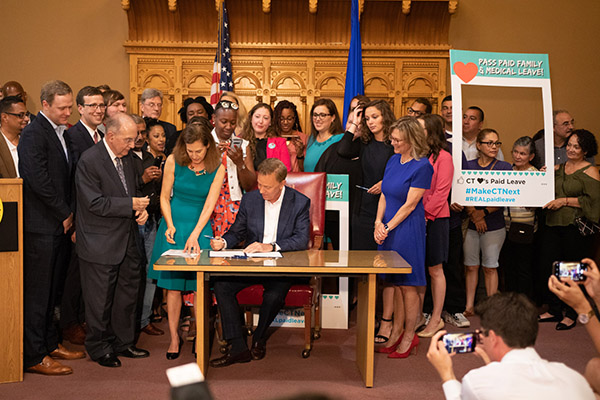Flexer Joins Governor for Signing of Paid Family And Medical Leave Program into Law

HARTFORD, CT – Today, Senator Mae Flexer joined Governor Ned Lamont and fellow legislators for the signing of legislation creating a statewide paid family and medical leave program into law. Connecticut residents will soon gain access to benefits allowing them to take time off work to care for a newborn child or a sick family member under the new bill.
“On the first day of the legislative session in January, my father was in Day Kimball Hospital. I spoke on the Senate floor about the privilege I had as a state Senator to be able to take time off that week and care for my family. This was the opposite of the time my dad was in a serious motorcycle accident and out of work for several months and my mom was left to care for a two-year old and a two-month old baby. I wonder how much different our lives would have been if there had been a paid family leave program back then,” Sen. Flexer said. “For more than five years I have been fighting for families in our state to have this benefit. Soon, people who work for a living in Connecticut won’t have to choose between their job and their family, because we finally approved a comprehensive paid family leave program that benefits both employers and employees.”
Paid family and medical leave in Connecticut comes as the state, and several others across the United States, work to match what is otherwise a global custom. The United States is the only nation of the 41 in the Organization for Economic Co-operation and Development and the European Union that does not provide any paid leave for new parents, and the United Nations’ International Labor Organization indicates 183 of 185 countries surveyed provide paid maternity leave; only the United States and Papau New Guinea do not.
Additionally, the legislation aims to support a changing family and household dynamic in the United States. In the last 45 years, the number of households with both parents working full time increased by 15 percent, and the number of two-parent households where the mother is not employed fell by 20 percent in that time. Connecticut joins Massachusetts, New York, New Jersey, Rhode Island, California, Washington and the District of Columbia in implementing these new programs.
Sustainable Funding
In Connecticut, personal disability leave and family care leave will be funded solely by employees. The program will be funded by a withholding rate of 0.5 percent, or one-half of one percent, on earnings up to the Social Security wage base. This is similar to other programs in other states. California funds its program with a 1 percent withholding rate on workers’ first $118,371 in wages; Rhode Island funds its with the first 1.1 percent of a worker’s first $71,000 in wages.
Who Benefits
Under the paid family and medical leave program, employees in the state will be eligible for 12 weeks of paid leave to care for a new child, a family member with a serious health condition, or to care for their own serious health condition. Additionally, employees can claim leave if they meet qualifying standards when an employee is on active duty, or if they are to serve as organ or bone marrow donors. Connecticut would be the first state to allow paid leave for such a donation.
Under the legislation, “family member” refers to a child, parent, spouse, domestic partner, grandparent, grandchild or an individual related by blood. It also refers to someone whose “close association to an employee is equivalent of a family relationship.”
Employee Coverage
Beginning on Jan. 1, 2022, the weekly benefit Connecticut employees can receive is 95 percent of weekly minimum wage earnings. The maximum benefit cannot exceed 60 times the minimum wage, meaning the maximum benefit will be $780 in 2022 and it will increase with the minimum wage until it reaches $900 in 2023 when the minimum wage increases to $15.
These benefits are similar to other states, which implemented maximum benefits ranging from $850 to $1,252.
Paid leave in Connecticut will apply to private sector employers with at least one employee, while self-employed and sole-proprietor employees can opt-in. Non-union state and local government employees are also covered, while unionized workers can collectively bargain to become covered. This is similar to paid leave programs in California, Rhode Island, Massachusetts and Washington.
Share this page:
